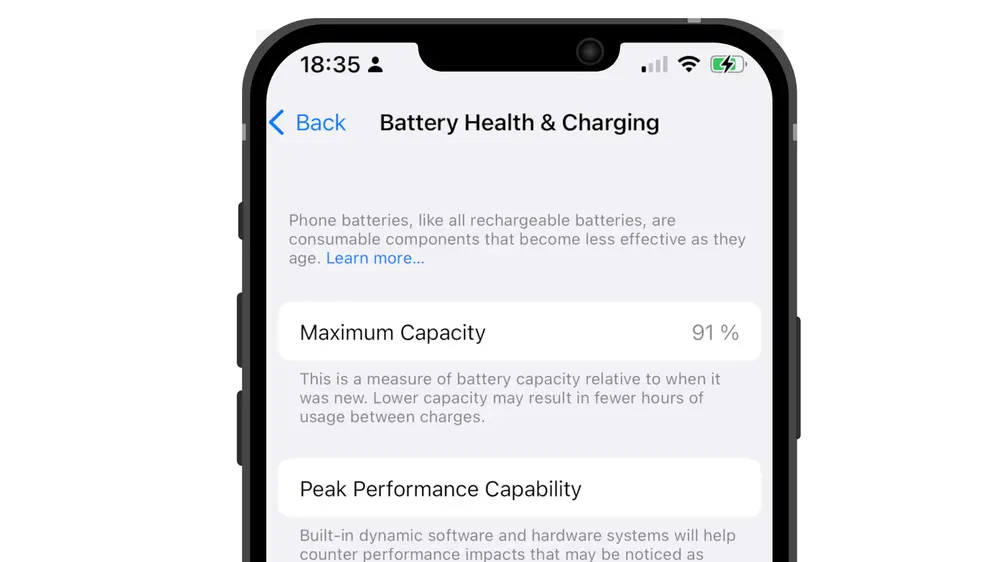What’s iPhone battery health and how to check it?
What does this battery health indicator ever exist? There is a reason why Apple had to add it in the settings, and why you should care about it.
iPhone battery health is an indicator made by Apple to determine if the performance of an iPhone should be lowered, and if the battery need to be replaced. You can check your iPhone battery health in Settings > Battery > Battery Health & Charging.
iPhone battery health has been introduced by Apple on the iPhone 11. To understand what is it exactly, you first need to know how an iPhone battery works, and why Apple choose to add this indicator on iPhones.
Don’t miss the tips about what to do if your iPhone battery health is low at the end of this post.

Lithium-ion batteries explained
iPhone batteries are Lithium-ion batteries, like every other smartphone today and almost any electronic device. This kind of battery is the best we can make for smartphones, as they are reliable, lightweight, and tiny.
How a Lithium-ion battery works
These batteries are named Lithium-ion because of the main chemical element that compose a battery.
A battery is made of 6 elements, a cathode, anode, electrolyze, separator, and two current collectors. The cathode is the part where an electron is missing, and the anode is where there are too many electrons.
Both cathode and anode store the lithium, and the electrolyze allows to transfer of positive Lithium-ions from the cathode to the anode, through the separator, and vice-versa.
When a device is plugged into a battery, here an iPhone, the electrical current will flow from the positive current collector, linked to the anode, through the iPhone to the negative current collector, linked to the cathode.
The positive Lithium-ions in the anode are sent to the cathode, releasing an electron while passing through the device, this process creates the current needed for the iPhone to be powered.
How is it charge
When the battery is plugged into the charger, the opposite happens from the discharge. Lithium-ion will go from the cathode to the anode.
When the Lithium-ions flow through the charger, they received an electron, making them positive again.
Once all the Lithium-ions in the anode are positive, and Lithium-ions in the cathode are negative, the battery charge is completed.
iPhone Lithium-ion battery performance degradation over time
Every Lithium-ion battery performance degrades over the battery cycle. A battery cycle refers to a full charge, from 0% to 100% of the battery. The more cycle a battery has completed, the more it degrades.
There are many reasons why a battery degrades over time, but the main one is because of the loss of Lithium-ions. Over time, the electrode structure ages, and some Lithium-ions get trapped somewhere between the anode and the cathode, resulting in less free Lithium-ions.
The less free Lithium-ions, the lower the battery capacity.
Some iPhone batteries history
Over time and models, Apple iPhone batteries changed and evolved. The bigger the iPhone model, the bigger the battery capacity.
Until the iPhone 8, iPhones could only be charged using 10W of power, with 5 volts and 2 amps, and the old iPhone charge was delivering 5W. With the iPhone 8, Apple released the fast charging features, that allow the iPhone to use 9 volts of voltage to charge the battery faster.
Apple also made changes on iOS regarding the iPhone battery, especially the battery's health. As the battery ages, the battery performance degrades, as we saw during the Lithium battery explanation. Once the battery ages too much, iPhones can have trouble performing some heavy tasks, as the battery can’t provide enough power.
Sometimes ago, iPhones experienced unwanted shutdown when the power provided by the battery was not enough, but with iOS 11.3, they released an update adding battery health information in Settings, noticing users when the battery should be replaced.
Later, they again released a new update, much more controversial, which would reduce the iPhone's performance in order to prevent the issues from happening once the battery is too old. But as they did not notice the users about performance degradation, Apple had to pay $113 million. Apple had to make the information appear clearly in the software.
What is iPhone battery health?
The iPhone battery health is an indicator informing users about how good or bad their still is.
The indicator is made by Apple and is not simply a percentage of the actual battery capacity compared to the original capacity. Indeed, the real battery health is quite different from what Apple's battery health indicator is showing.
Nobody knows the secret formula Apple uses to determine an iPhone battery's health, but it has to take into consideration the maximum power an iPhone battery can deliver, among some other useful battery parameters.
Apple recently changed the “battery health” indicator to “Maximum capacity”, but only the name changed. The battery health indicator on your iPhone is a good way to know if you should replace your iPhone battery, but it also gives you another precise information.
The battery health is an important indicator on iPhones, as the software will use it to manage the performance of the iPhone. Indeed, iOS has a performance management feature, to avoid unexpected shutdowns and other issues on iPhones. This process is using battery health to manage performance.
Where to check iPhone battery health?
You can check your iPhone battery health under Settings > Battery > Battery Health & Charging. Here is a small tutorial video to help you find the battery health, or maximum capacity, on your iPhone.
But this indicator made by Apple does not tell you exactly the difference between the actual maximum capacity of your battery and the original maximum capacity, which many name real battery health.
Check Real iPhone battery health
Hopefully, there is still a way to find out what is the real battery health of your iPhone. There are many data available in the Analytics Files of our iPhones that allow us to calculate the real battery health.
To check your iPhone's real battery health, you need to go to Settings > Privacy & Security & Analytics & Improvements > Analytics Data. Open the latest Analytics-xxxx-xx-xx-xxxxx-.ips.ca and send it to this shortcut.
I give your more detailed steps to check the real battery health using this Siri Shortcut here.
How to maintain your iPhone battery health
The easiest way to maintain your iPhone battery health is to use less battery. As the more cycle, your battery has, the worst is your battery health, so you want to decrease battery usage.
Of course, nobody wants to stop using their iPhone just to protect the battery's health, but you might want to reduce the battery usage of your iPhone. The less your iPhone loose battery percent, the less cycle your battery will do, and the better will be your battery health.
Every trick you can find to save the battery life of your iPhone will also help to maintain your battery health. Here is a short list of some of these tricks:
- Enable automatic display brightness. Screen usage is the most battery-consuming usage, reducing your screen brightness will save some battery life. Enable the automatic feature so your iPhone will manage your screen brightness by itself.
- Use low power mode more often. Low power mode will limit some of your iPhone features in order to reduce battery usage. Your iPhone usually asks you to enable it once the battery reaches 20% and below, but you can still choose to enable it manually.
- Prefer a Wi-Fi connection over a mobile connection. A mobile connection can use a lot of battery, especially if you are far away from a mobile antenna, and the signal is weak. Wi-Fi connection on the other side, does not use so much battery.
- Enable 5G Auto in mobile data, or disable 5G and choose the 4G option. You can choose different options in Settings > Mobile Data > Mobile Data Options. 5G is using much more battery than 4G, I prefer to choose the 5G Auto option so my iPhone is only using 5G when it really needs to.
- Delete all unused applications. Each application installed on your iPhone can shorten your battery life, especially the ones that have some background refresh or synchronization. From time to time, I check all my applications and delete the ones I did not use for a while.
- Allow all background synchronization only on Wi-Fi connections. For the same reason that it’s better to use Wi-Fi over mobile data, be sure that all the synchronization can only be made while your iPhone is connected to Wi-Fi, such as iCloud backups, Photos, and Music synchronizations.
Apart from saving battery life, you can enable some features and take new charging habits to maintain your iPhone battery health.
What’s the best way to charge an iPhone
There are a few things you can do, related to battery charging, that can help to maintain your iPhone battery health.
Enable “Optimised Battery Charging” in Settings > Battery > Battery Health & Charging. This feature is reducing battery aging and protects the battery's health. Your iPhone will learn about your daily charging routine so it can wait to finish charging once 80% is reached until you need to use it. Basically, when you charge your iPhone overnight, it will first charge up to 80% battery and will finish the charge only before your waking up alarm.
Avoid letting your iPhone plugged into your charger while fully charged. It does not make so much difference when you do this once or twice, but over the lifetime of your iPhone, you can save a few percent of battery health with this new habit.
Use a better iPhone charger, this can make a huge difference, especially if your charger is not a reliable one. Chargers need to deliver a specific voltage on the output, some of them don’t have a correct output, or the output voltage is not stable. I use this charge from Belkin for years now, and I do not have big issues with my battery health.
For the same reason, I also recommend using a good lightning charging cable. A bad or damaged cable can have an impact on the current delivered from the charger to your iPhone. A good lightning cable is not very expensive but is an important component of the charger.
What to do with a Low iPhone battery health?
First, do you really think your battery health is too low on your iPhone? If you are still happy with your iPhone, is there any reason to worry?
What’s low battery health on iPhone?
Low battery health can have two different meanings, the one from Apple, and the one for people wondering if there is something to do about their iPhone battery:
- Low battery health, according to Apple, is a battery health that reached 80% or below of the battery's maximum capacity.
- Low battery health can be different according to you than according to me. Battery health should be considered low when, because of this battery health, you have trouble correctly using your iPhone. For some people, battery health will be low way before it reaches 80%, for others 80% of battery health is still good enough.
What happens with low battery health
When your battery health is dropping too low on your iPhone, the performance is reduced by the software. As the battery's maximum capacity is dropping, the maximum power the battery can deliver is also dropping, and if your iPhone is asking for more power than the battery can deliver, some unexpected shutdowns can happen.
To avoid this, iPhone 11 models and later are now dynamically managing performance depending on the battery health. No features are disabled, but you could still see the difference if your iPhone is reducing the performance.
You could notice longer app launch times, lower volume on the speakers, and lower frame rate on some tasks, with many other effects. Camera, sensors, networking, and Apple Pay can’t be impacted by this performance management process.
Reset the battery health by changing the battery
Now, you should better understand what battery health should be considered low, and what it means. If you think that your iPhone performance is too low, or that the battery is not lasting long enough, there are not many things to do unfortunately.
To reset the battery health, and therefore retrieve the maximum performance on your iPhone, you need to replace the battery. Either you choose to go to an Apple Store, or a repair store, and ask them to replace your iPhone battery, the replacement is not long. Or you can also do the battery replacement yourself, here are the best iPhone batteries replacement you can find.
If you have more questions regarding iPhone batteries, here are some of them answered.










Post your comment